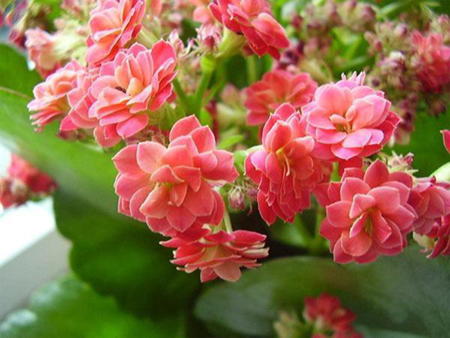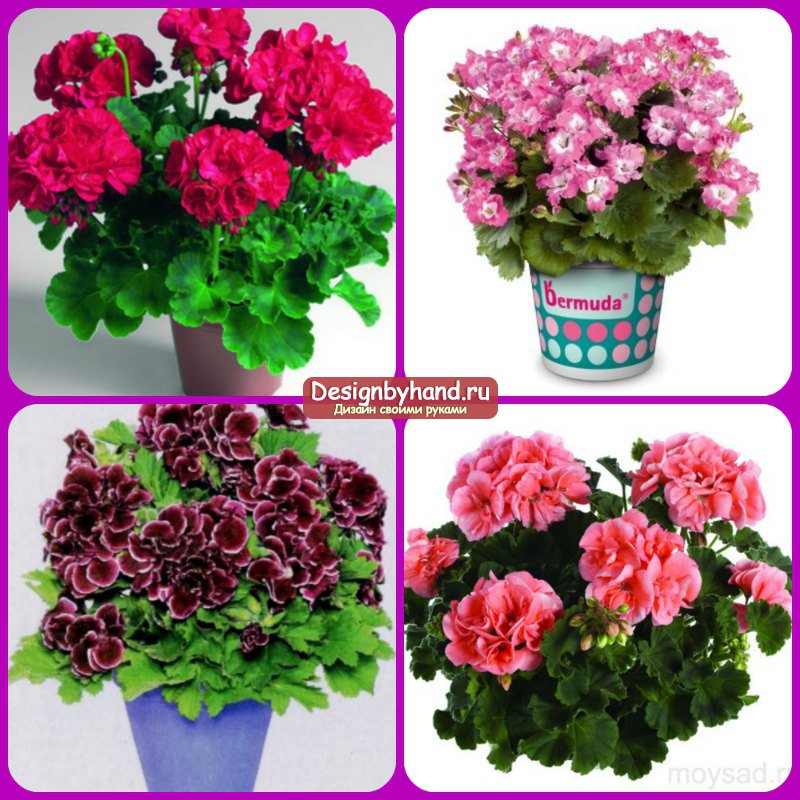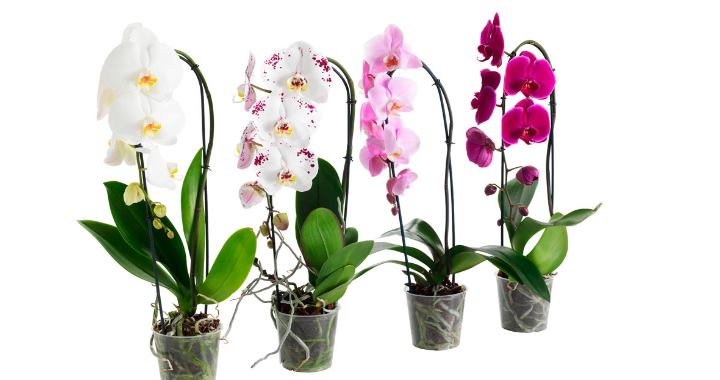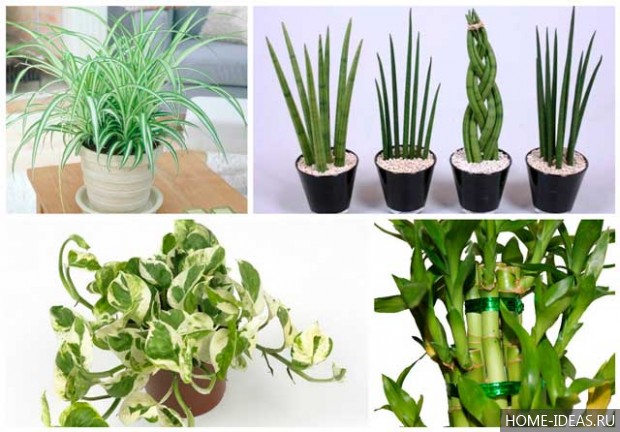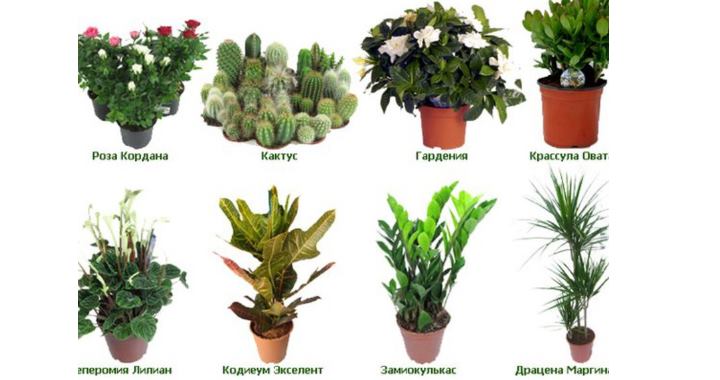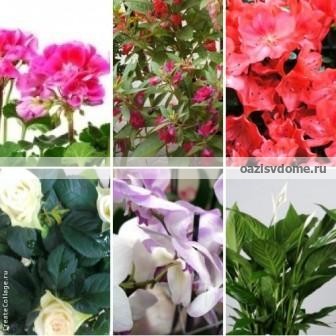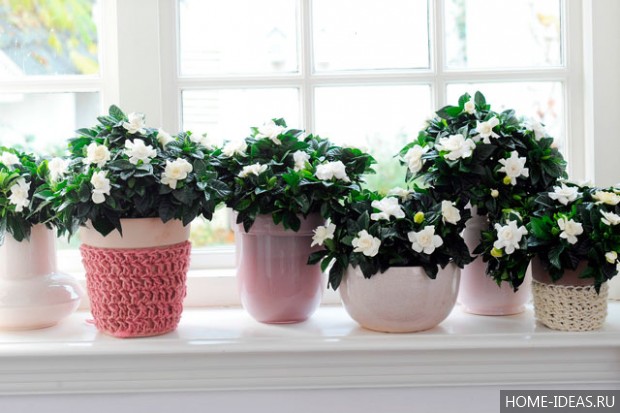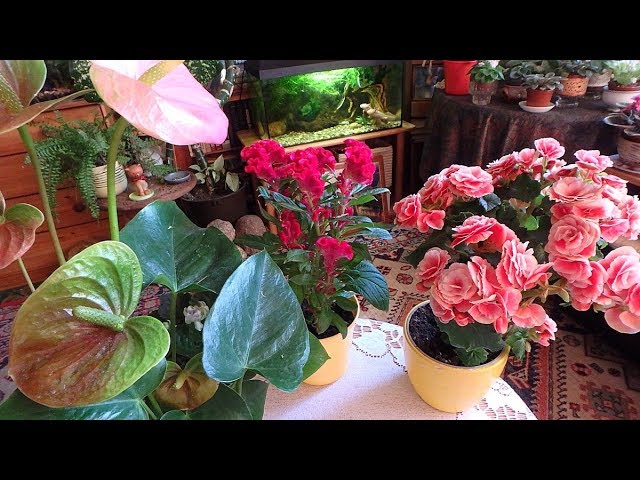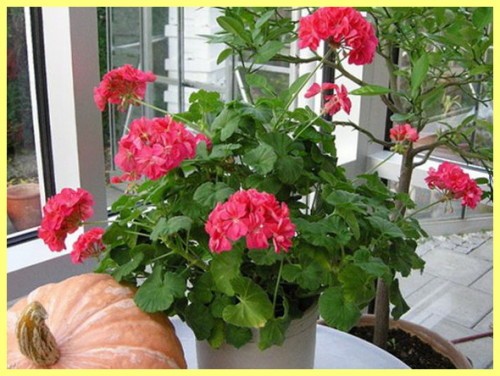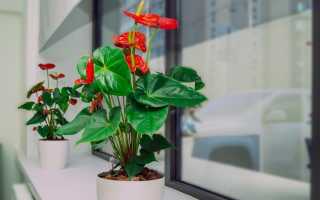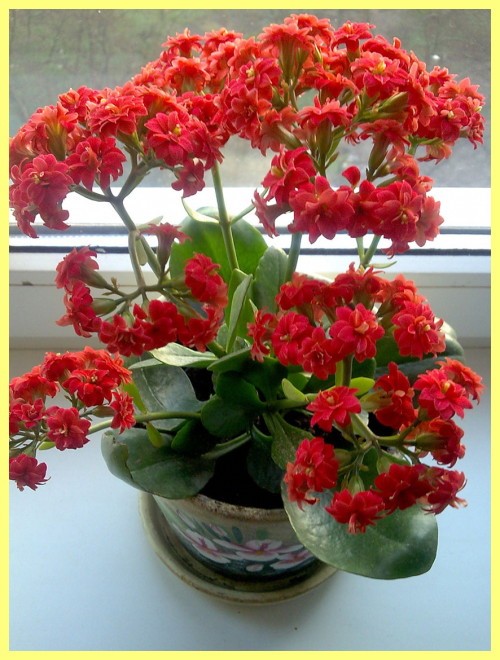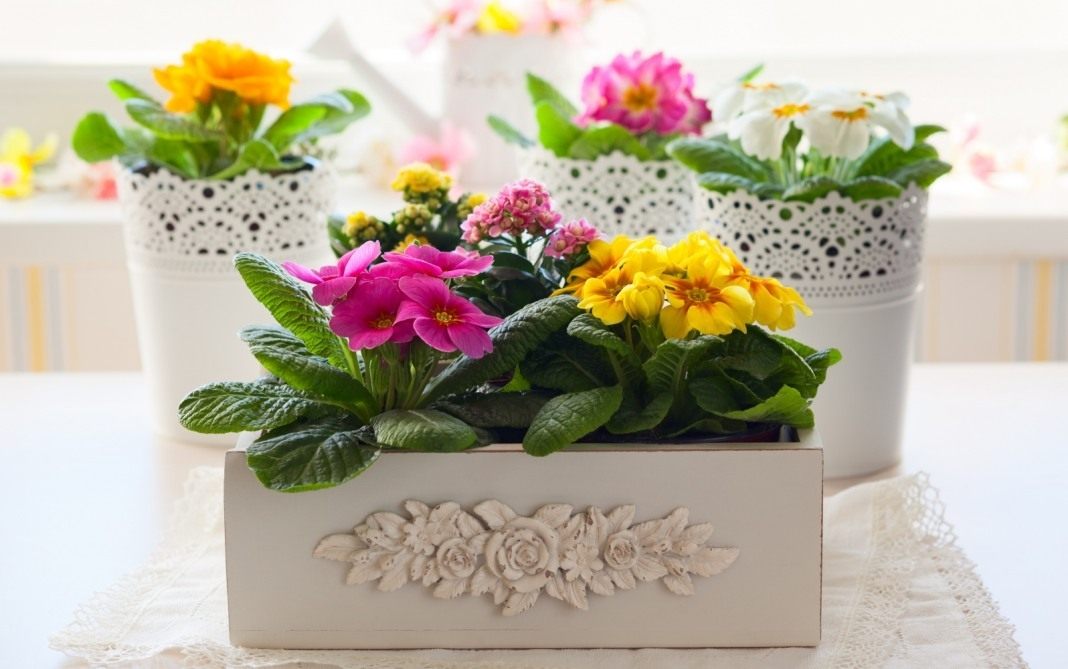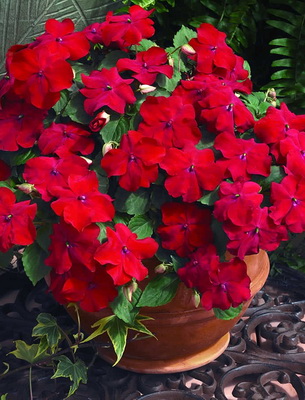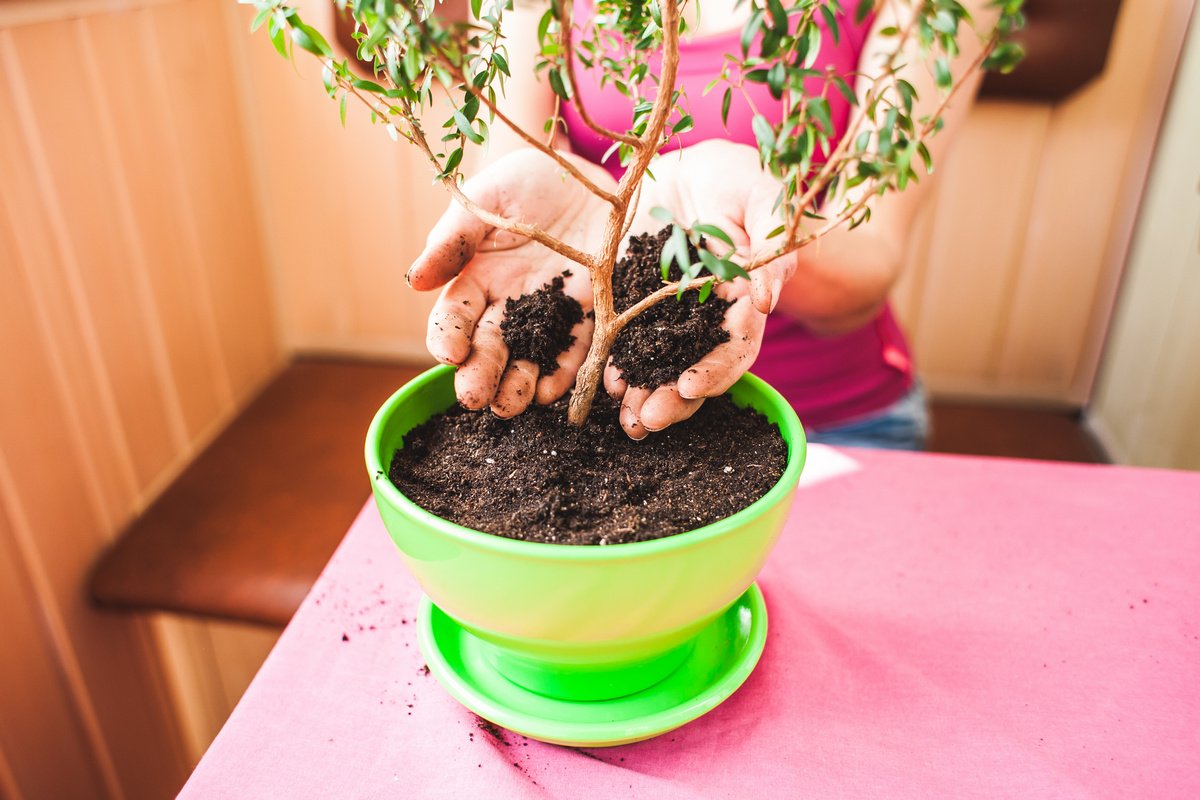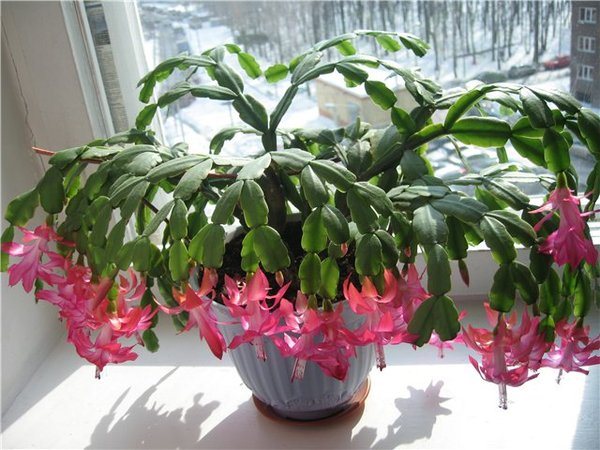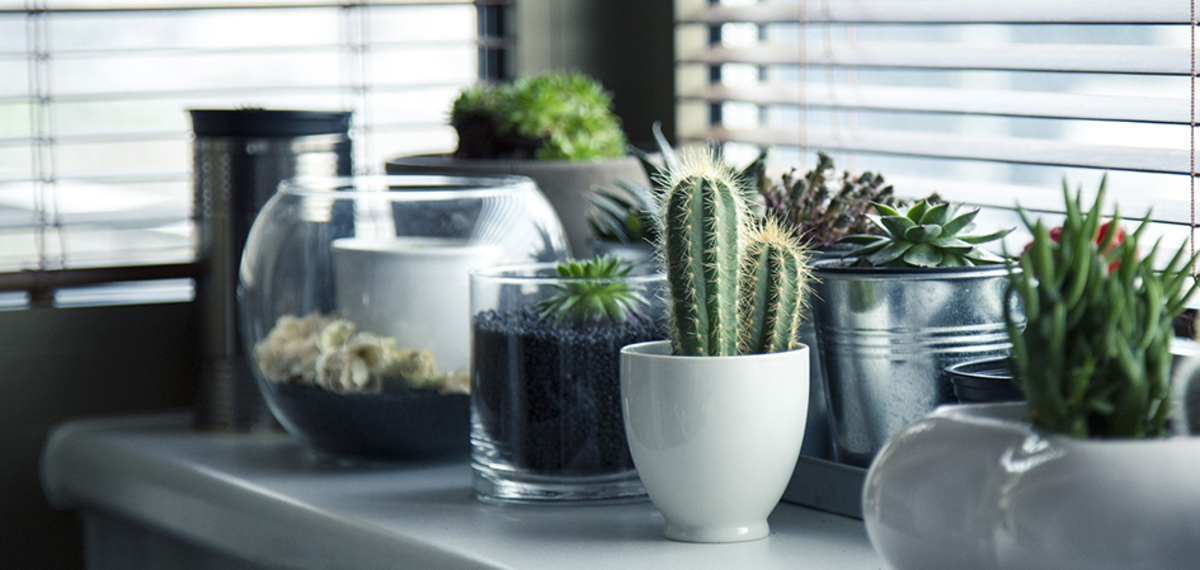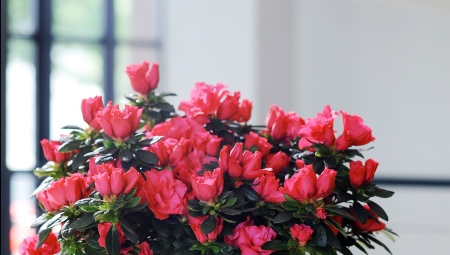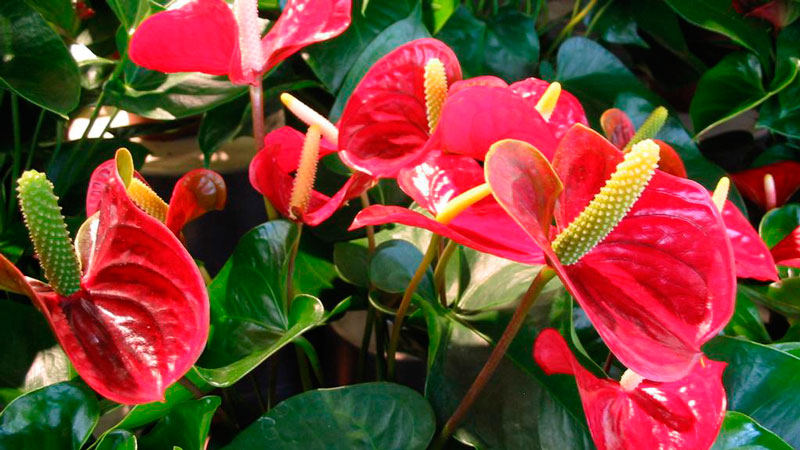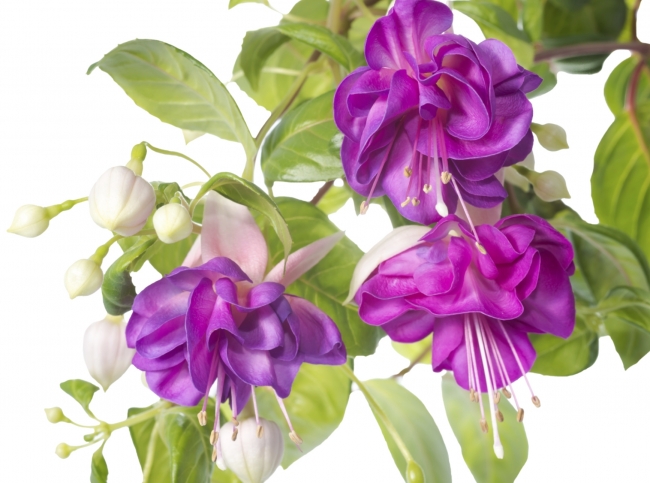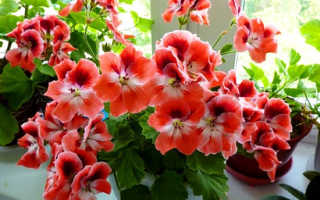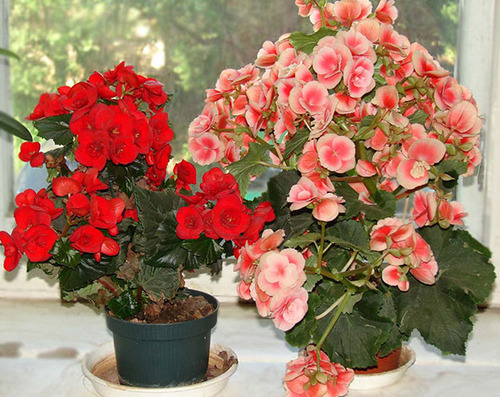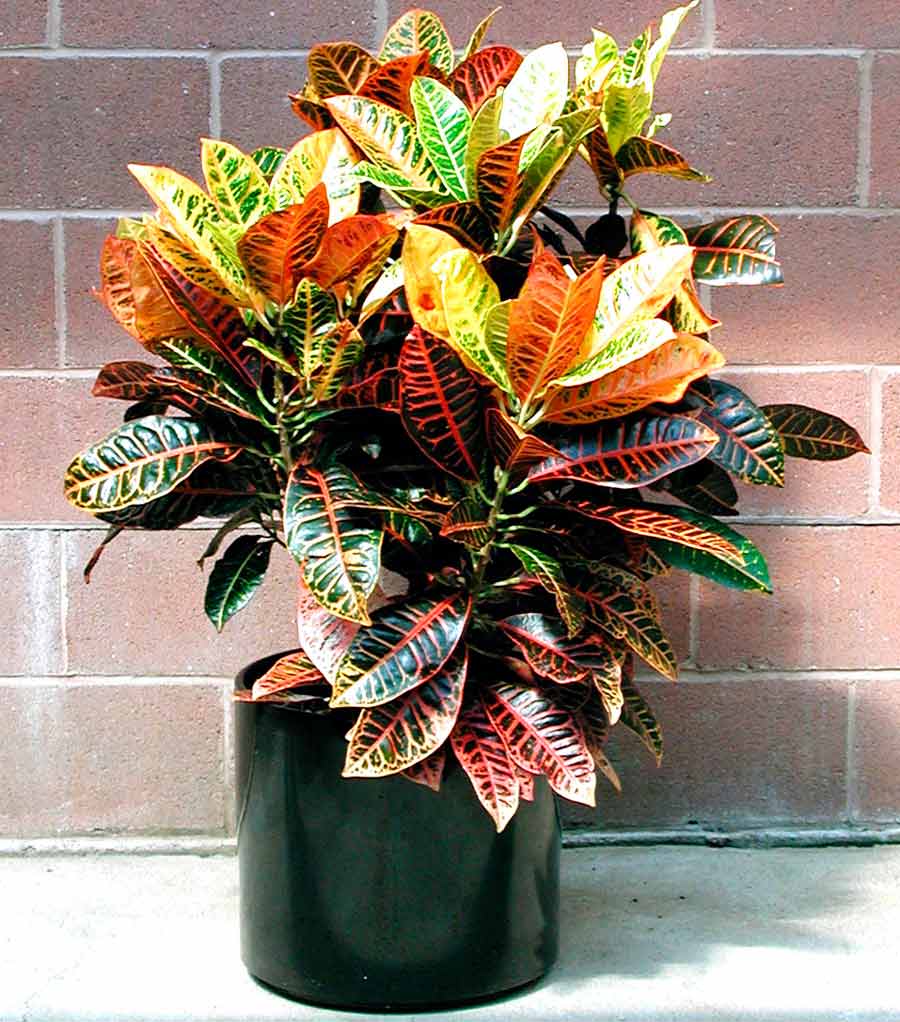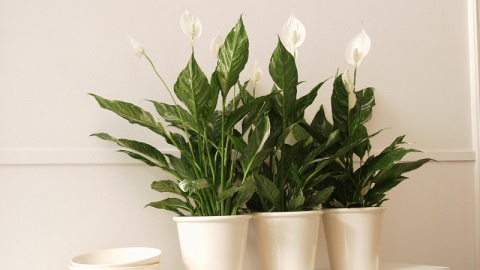Other popular year-round houseplants
Abutilon (indoor maple) can bloom in early spring and bloom until early November. It is classified as an ever-flowering houseplant with sufficient lighting and proper feeding. The leaves of the plant are similar to maple, large flowers are red and orange in the form of bells. It is called the "flower of happiness."
Indoor rose is a compact bush up to 50 centimeters in height, covered with beautiful buds. Usually does not have a strong scent like a garden rose, which is suitable for placement in a bedroom. For year-round flowering, a rose needs good sunlight, high indoor humidity, and room temperature.
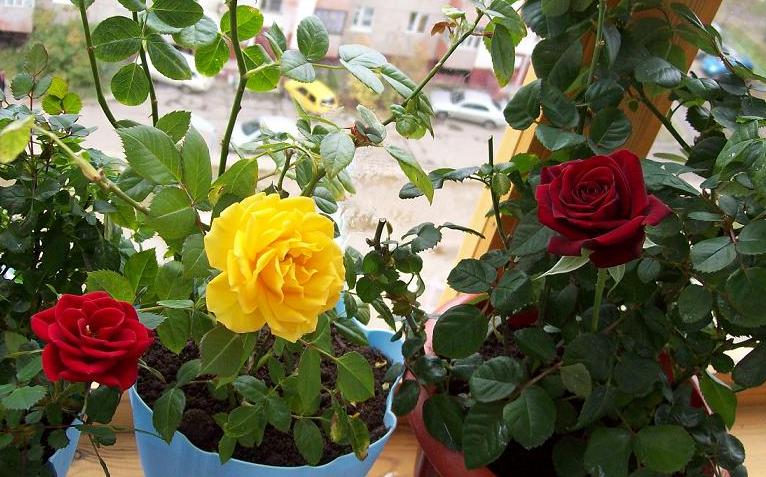
Indoor rose is placed on windowsills oriented to the west.
The Chinese rose (hibiscus) blooms from March until the beginning of the winter season. It is a huge bush with large red flowers.
Anthurium belongs to ever-flowering indoor plants. The flower is bright in color, looks like a waxy one. Leaves are oval, glossy. The conditions for constant flowering are good sunlight, uniform watering, and a temperature of 18-20 degrees.
Important! The flower must be sprayed and wiped from dust
Fuchsia

To some extent refers to the "grandmother's" flower. Since ancient times, fuchsia has settled in our homes and lives safely to this day. They love her not only for the fact that it blooms continuously, but also for the touching beauty of the flowers. On thin twigs, fuchsia flowers with long stamens and a pistil look like fabulous fairies in short lush dresses with thin legs. Previously, only pink and purple were available for fuchsia. And today, after the breeders have worked on these indoor beauties, the color palette of fuchsias has expanded significantly.
For a rich bloom, place the planter where there is a lot of ambient light. The pet loves regular leaf spraying. Feels good on the balcony in the warm season. In the summer you need to water it more often. In winter, let it dry slightly. For vigorous flowering after the first flowers have fallen, you need to shorten the lashes of the ampelous beauty by a quarter.
Geranium
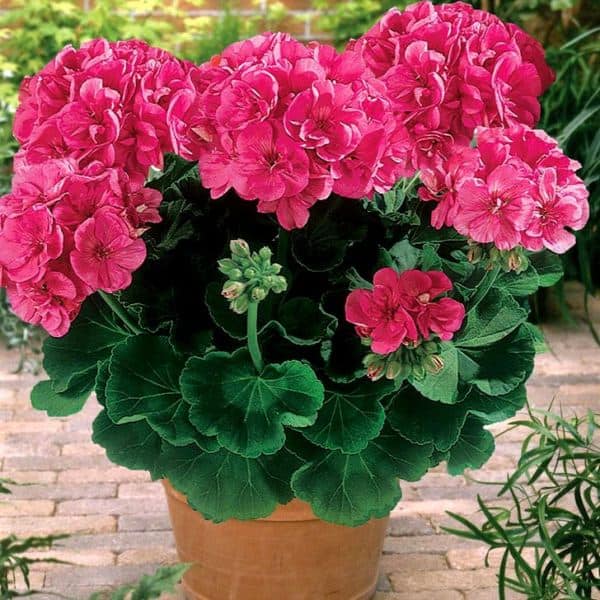
This is the most popular houseplant in Soviet times; during perestroika, interest in it disappeared. Only recently they began to drop him out in their apartments again. And for good reason! Geranium is not only very beautiful, unpretentious, has a wide palette of colors, but also has medicinal properties.
They can often be seen on balconies, as they can easily withstand air temperatures from 7 to 26 degrees. They love a lot of air, so in the summer, putting pots with this plant on the balconies is the best option. It can be watered rarely, but abundantly. It is not necessary to spray it.
He does not like tightness, so only three seedlings are enough in one small pot. In winter, it can bloom in a room if the air temperature is optimal for it and regular feeding is carried out. It is not required to repot it regularly, it can bloom for years in the same pot. You just need to periodically add earth from above. And it is advisable to protect pets from geranium, as it can taste dangerous to them.
Geranium (pelargonium) zonal

It is more correct to call this plant precisely pelargonium. Geranium is a garden plant or even wild. But today is not about that, today about the flowering of this beauty. Pelargonium has always been considered an essential attribute of home warmth and well-being. The palette of color shades is so delightful and multicolored that it allows you to have many specimens of geraniums in your home, suitable even for the tastes of the most discerning aesthetic florists.
The green leaves of the plant have a pungent aroma. This smell can cause headaches in sensitive people. For the rest, this is a gorgeous plant. Lives well on any windowsill. Bring the geranium to the balcony during the warm summer, she will appreciate it. These flowers, blooming all summer long, are very fond of fresh air.
She loves the sun and can easily be on the hottest windows, where the rest of the flowering plants cannot survive. However, this does not mean that you need to "fry" geraniums in the heat. Be kinder. Lightly shade your pet with tulle, remove for the hottest period, placing it on the table in front of the window. If pelargonium is on an open loggia in summer, water it more often. In the heat, the earthen lump dries up very much. But again, remember to be in moderation. The bushes of the plant feel great in the temperature corridor from +8 degrees to + 25 - these are the most comfortable indicators.
Break off the flower stalks that have faded. Remove dried leaves, prune weak branches from the bush if necessary - that's the whole care. Pelargoni is so unpretentious that the bushes can be planted in a flower bed in summer, and autumn can be taken back into the house.
Popular varieties
Among domestic long-flowering plants, such are distinguished.
Abutilon
A beautiful variety with yellow buds that looks like a maple tree. The peak of flowering occurs in the summer. Abutilon pleases its owner from early summer to late autumn. Miniature "maple" is included in the winter recreation area. With regular watering and artificial lighting, a spectacular plant will bloom all year round. Abutilon needs to remove incorrectly growing shoots. There are hybrid varieties. Their color and shape of the buds is striking in its variety.

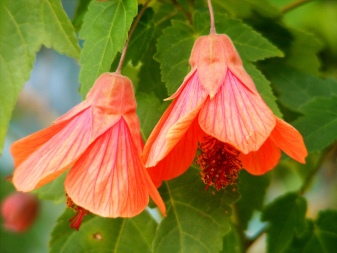
Geranium
An amazing, long-flowering plant that has a pronounced aroma that repels annoying insects. In addition, geranium cleans the air of bacteria and viruses. As for the color, the buds of the plant amaze with a riot of colors. There are geraniums with raspberry, scarlet and snow-white inflorescences. A favorable place for a flower is sunny and dry. In a cold, damp room, the plant will die. In the sultry summer, the flower requires frequent watering; in the winter, geraniums are watered less often. For a plant, it is not necessary to buy a roomy pot, a small container will do.


Balsam
A beautiful indoor flower that pleases with its flowering every year. He loves light and warmth. However, too bright lighting can harm it. Balsam requires watering, especially in summer. Many connoisseurs of ornamental plants call it "light". Differs in lush flowering. The buds are colored red or crimson. From a distance, the flower really resembles a small fire.

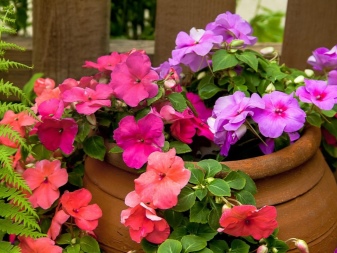
Hibiscus
A fascinating ornamental plant that resembles a sprawling bush with bowl-shaped buds. The inflorescences are painted in a bright purple hue. However, there are varieties with snow-white and raspberry buds. Hibiscus blooms all year round and does not require much maintenance. It is enough to water it in a timely manner and protect it from drafts. Also, the plant needs a lot of light and timely fertilization.


Gardenia (jasmine rose)
A delightful decorative flower that looks like a rose. However, the plant is quite moody. He needs sufficient lighting and regular watering with acidified water at room temperature. At the same time, almost all connoisseurs of beautiful ornamental plants adore gardenia for its amazing appearance.
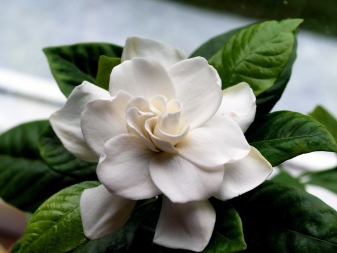

Saintpaulia
Outwardly, the flower resembles everyone's favorite violet, however, it differs from it in its unpretentiousness. It is a miniature shrub with leathery leaves and vibrant buds. Requires moderate watering and prefers a dark place. Withered buds are best cut off.


Ivy
Ivy is used and loved by many flower growers, as well as room designers. The plant has original leaves of an unusual shape. One of the main features of ivy is its fairly rapid growth. In a few months, the plant can "arrange" a medium-sized room.

Ivy is undemanding to light and builds up its mass well, even being in the back of the room. As for watering, this plant can be called ideal for forgetful people.Yes, the petals from lack of water can wrinkle and dry out, but as soon as you sprinkle them and give the roots food, they come to life as if nothing had happened.
For planting and decorating rooms with ivy, pots are mainly used, and the stems are fixed in the necessary places using fishing line or special supports. A good half of ivy varieties do not bloom, so many growers recommend this plant for allergy sufferers.
Houseplants blooming all year round
These indoor plants can be divided into two groups. The first group is those flowers that need constant attention and self-care so that they can bloom with a single beautiful flower. The second group - bright, rich flowering plants and are in high demand among housewives.
- Violet. Bright, with lovely charm, these flowers will not leave anyone indifferent to their beauty. Bloom almost all year round. A wide range of colors, a variety of shapes and textures of inflorescences allows you to collect a decent collection of violets on the windowsill.
- Orchid. Refers to exotic species. It wins the hearts of flower growers with its gorgeous beauty, and pleases with long flowering. The most unpretentious of the orchids is the Phalaenopsis variety. Breeding a variety of hybrids allows everyone to grow and maintain orchids without spending a lot of time on it.

Category of decorative flowering potted species
This group is characterized by very different flowering times. This allows you to choose flowers in such a way that the house is filled with bright colors and fragrance throughout the 12 months.

Indoor gerbera
Florists consider such plants as the most attractive representatives of this category:
azalea. The amazingly beautiful azalea native to the Middle Kingdom is characterized by the presence of delicate flowers of very different colors. Their petals can be white, pink, but the most popular are red. The buds begin to open in December and continue until April. Azalea is completely undemanding to care and living conditions. She will need watering, as well as a large amount of diffused daylight;
anthurium. This plant, also referred to as male happiness, is quite capricious. In addition to regular watering, he will need clean air, ventilation, maintaining a high level of air humidity, protection from wind and drafts;
begonia. This blooming indoor flower is completely unpretentious, does not require special attention to itself. Florists will appreciate the variety of varieties that differ from each other in the shade and shape of the buds;
gerbera. The homeland of this plant is South Africa. It's no wonder the gerbera is pretty moody
She will need timely moisture, a lot of sunlight (it is important to shade the flower). The height of an adult gerbera can reach 60 cm;
orchid
Orchid flowers can be either monochromatic or variegated. The plant loves a large amount of scattered daylight, high humidity of the air and substrate;
pelargonium. Outwardly, the flower looks like a familiar geranium. The soil for pelargonium should be either neutral or slightly acidic. For the flowering to be generous, the flower should be cut, leaving three internodes;
the Rose. The most capricious plant. However, subject to all the rules for caring for the culture, the rose will bloom in the spring, and flowering will end only in the fall;
campanula (bells). These indoor flowering plants delight flower growers with their bright colors from March to November. The culture needs preparation for a period of rest and wintering.

Campanula
Pelargonium royal

This type of geranium amazes with the beauty of its flowers. Many, seeing for the first time, begin to dream and dream about her. Someone decides and gets a "queen", she dies, and the idea seems empty. However, royal geranium also belongs to unpretentious perennial flowering flowers.Having made friends with her once, you can admire the riot of colors no less than in the presence of zonal pelargonium.
The "queens" have sharper leaf plates, and the shape of the flowers vaguely resembles the shape of pansies. Flowers in most cases are multi-colored. But there are also monochromatic pelargoniums, which in no way diminishes their external chic. Watering such a beauty should be moderate. Each time a clod of earth should dry out by half. Do not pour over the stem and leaves. In the spring, it is also customary to "trim" the plant, but this must be done very carefully. This pelargonium lays new flower buds in the cold, so it also feels great not only at + 25, but also at +6 degrees.
Ruellia

This is a very beautiful houseplant that can bloom all year round. True, each of its velvet flowers lives only one day, but a new flower soon grows in its place. He does not like direct sunlight, it is advisable to put it in partial shade or in a well-lit place where the rays do not reach.
They water it only when the soil becomes dry, but ruella loves moist air, so it is better to put a container with water nearby or the pot can be placed in a tray with wet expanded clay. If the air is often dry, ruelia can shed its leaves. For the same reason, she does not like drafts.
Despite the fact that it is considered blooming all year round, it still has a short winter break when it rests and gains strength before blooming again. Ruellia actively branches, therefore, in order to avoid abundant overgrowth to the sides, it is advisable to cut it a little in early spring. Unfortunately, in our time it is practically not found in stores, since due to its rapid flowering, it is not in proper demand.
Calathea
Calathea is a perennial plant native to South America, therefore it is quite capricious. It will take patience and care to look after him.

The optimum temperature is in the range of 20-24 degrees. Do not allow sudden changes and protect the plant from possible drafts.
Despite the fact that this is a tropical plant, calathea does not like direct sunlight, so it is important to find a place for it where there will be enough light, but not too much (for example, not far from a window). Calathea loves high humidity, up to 90%
It is difficult to achieve such an indicator in an apartment, so you need to regularly spray the leaves. If the leaves are velvety, then spray only the air around. You can also pour pebbles into the pan and pour water so that the bottom of the pot with the plant does not touch it. Watering 2-3 times a week
Calathea loves high humidity, up to 90%. It is difficult to achieve such an indicator in an apartment, so you need to regularly spray the leaves. If the leaves are velvety, then spray only the air around. You can also pour pebbles into the pan and pour water so that the bottom of the pot with the plant does not touch it. Watering 2-3 times a week.
The soil should be breathable, free of excess calcium and nitrogen. A young plant can be transplanted once a year, then once every 2–4 years.
Balsam
 Balsam is colloquially called "light". Its single, large flowers have long, curved spurs. During the flowering period, leaves are almost invisible behind the flowers; from a distance it seems that there is not a plant in the pot, but a small bright light. And balsam blooms for a very long time - from June to October.
Balsam is colloquially called "light". Its single, large flowers have long, curved spurs. During the flowering period, leaves are almost invisible behind the flowers; from a distance it seems that there is not a plant in the pot, but a small bright light. And balsam blooms for a very long time - from June to October.
Balsam is photophilous, but does not tolerate bright sunlight. You cannot put it where the sun is directly shining. It is hygrophilous, on hot days it needs to be sprayed with water. He also loves warmth, but not heat (from +15 to +25 degrees).
According to the conditions of detention, it is ideal for urban apartments, in which, as a rule, there are no extreme weather conditions. It feels great in artificial light.
You just need to make sure that they do not stand too close to each other. In this case, they can shed their leaves.Leaves can also fall off from cold and lack of light.
It is better to propagate balsam by cuttings removed from the top (about 3 cm long). Cuttings root in any solution or substrate. The best soil for balsam is a mixture of humus and leafy earth with a small amount of sand added.
When the age of balsam reaches 3-4 years, it is better to transplant it, because young plants bloom more abundantly than old ones.
Fuchsia
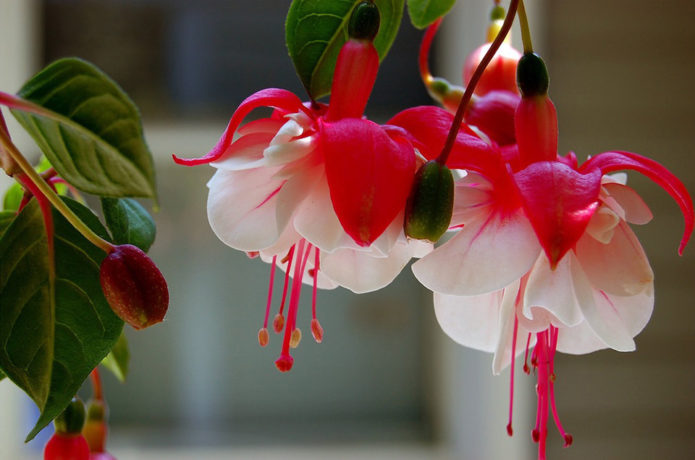
Fuchsia feels great in rooms with artificial light. It blooms richly from early spring to late autumn. During this time, fuchsia can be kept on the balcony or in the garden.
For flowering to be longer, after the first flowers fall, they should be pruned and fed. In winter, fuchsia needs to be watered rarely, and in summer - often and abundantly.
When fuchsia hibernates, it sheds its leaves, and by spring it is again covered with them. Fuchsia definitely needs rest, otherwise it will bloom badly during the season.
During the flowering period, do not rearrange the pots, move them from place to place. The plant can shed its buds.
The easiest way to propagate fuchsia is with large, mature leaves with strong petioles. Pull the leaf off the stem with a precise and sharp movement. A bud will sprout from the bottom of the petiole, which will develop into an adult plant.
Fuchsia is unpretentious to the soil, but it feels best in a mixture of leafy soil, black soil, peat and sand (sand is half as much as the rest of the components).
Abutilon
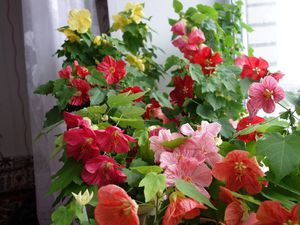 Due to its characteristic leaf shape, it is called indoor maple. This is a surprisingly unpretentious household inhabitant, requiring only regular but moderate watering and constant lighting.
Due to its characteristic leaf shape, it is called indoor maple. This is a surprisingly unpretentious household inhabitant, requiring only regular but moderate watering and constant lighting.
To make the flowering more persistent and long-lasting, abutilone can be fed with potassium nitrate and superphosphate. In the spring, he needs a strong pruning - one third or even half of all shoots.
Abutilone propagates by cuttings in spring or summer, and the best soil for it is turf, humus, leafy earth with a small addition of sand.
Begonia

Begonias
Begonia can bloom all year round if properly cared for. It has a wide variety of colors and rich foliage. The inflorescences have an attractive edge.
Care
- They love bright lighting, so it is worth placing them on the sunny side, but so that direct sunlight does not fall on the plants.
- Room temperature is ideal for full development and flowering.
- Begonia loves moisture, but it is not recommended to spray it, because brown specks may appear on the leaves. You just need to place the pan of the pot on a damp surface.
- Watering should be plentiful in warm weather, and moderate in cold weather.
- The subcortex is carried out at the beginning of flowering.
- For transplanting begonias, it is better to use leafy soil with peat and black soil.
- Begonia propagates by dividing the plant, cuttings or stems.
The best varieties of ever-flowering indoor plants
Flower lovers prefer low-maintenance plants. These are unpretentious species that multiply easily, grow quickly and bloom most of the time. It is enough to plant a layer or a leaf in the ground, do not forget about watering and form an overgrown plant. The most common varieties that have long won popular love and popularity are listed below.
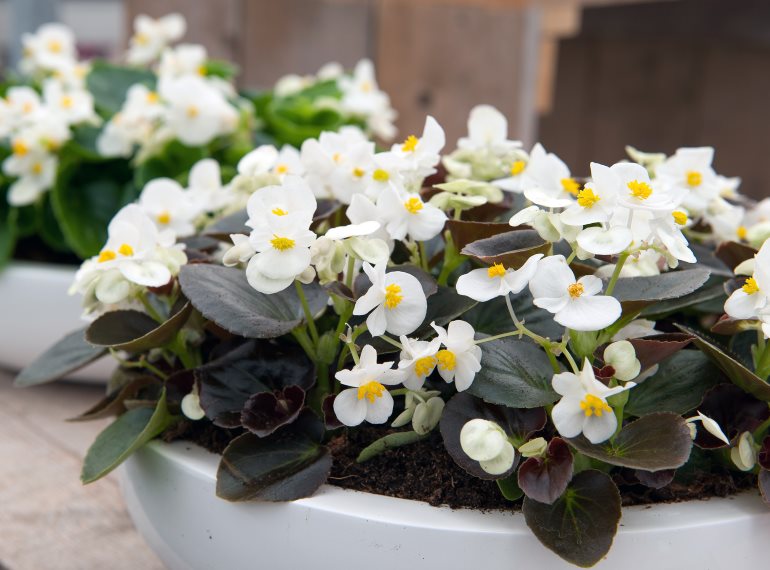
Growing begonias on a windowsill
Geranium (pelargonium)
A wonderful home long-blooming indoor flower, successfully grown on a windowsill. It has many varieties. Umbrella inflorescences of pink, red, orange, white shades cover the plant. The flowers are simple and double. Plant height 30-60 centimeters.
Up to 30 different varieties are grown in the apartment. Geranium farming techniques are very simple. Loves the sun, in summer it can withstand heat up to 30 degrees. Prefers cooler air in winter. In summer, it needs regular abundant watering, in winter it is watered as the soil dries up.Geranium is so undemanding that it easily tolerates drying out of the soil, abundant watering will quickly bring it back to normal. For the splendor of the bush, it is regularly cut off. In summer, the flower can be planted in open ground or taken out to the balcony.

Geranium decorates the balcony
Important! Geranium blooms all year round, so it needs feeding. Use phosphorus fertilizer for flowering plants
Usambara violet (Saintpaulia)
Favorite plant of flower growers due to its many shapes and colors. Blooms all year round. It takes up little space on the windowsill, so it is possible to grow several types of violets at once.
Ideal for placement of east and west windows. Shading is needed on the southern windowsills. Optimum temperatures for growing are 21-24 degrees, without sudden changes at night. Loves humid air, but does not need spraying. In warm weather, watered 2 times a week.
Ever-flowering begonia
Perennial with juicy thick green leaves. Lives up to its name and blooms continuously as long as conditions are favorable. Begonia has large and small flowers, collected in axillary inflorescences. Species are widespread in red, pink, salmon, yellow colors.

Begonia has lush terry forms
Loves diffused sunlight. Grown on the southeast or southwest side. During the period of active growth, abundant, frequent watering is needed, in winter it is reduced.
Important! With waterlogging, the stem rot and the flowers fall off. The growth of begonia begins quickly, and the bush requires periodic rejuvenation.
Does not like sudden temperature changes: not lower than 16 degrees in winter, in summer not higher than 25. Fertilized in spring and summer 1 time in 2 weeks with a concentrate for flowering plants
Begonia growth begins quickly, and the bush requires periodic rejuvenation. Does not like sudden temperature changes: not lower than 16 degrees in winter, in summer not higher than 25. Fertilized in spring and summer 1 time in 2 weeks with a concentrate for flowering plants.
Indoor plants in the interior of the apartment
Any apartment with indoor plants comes alive and becomes more comfortable. In modern floristry, you can see hanging compositions of liana-like plants. They are also often placed on the refrigerator in the kitchen to liven up the interior.
In modern high-tech design, dracaena is used under bamboo or flowers with straight and strong leaves.
For owners of darkened apartments, but who love flowering plants, female and male happiness is suitable. These are spathiphyllum and anthurium. These flowers are quite unpretentious and have a beautiful color.
In the interior decor, you can assign colors to different places.
Compositions on the windowsill
For example, compositions on the windowsill. You can place violets of the same size and in the same pots. They will give a uniform style to the interior, and the color of the pots can be associated with the general shade of the furniture.
Or create a whole garden using decorative crystal soil and stones.
Use tall plants only at the corners of the window to avoid shading the room too much.
 Flowers on the windowsill
Flowers on the windowsill
Hanging compositions
Hanging compositions will perfectly decorate the dining area or relaxation area. For them, liana-like unpretentious houseplants are used. If necessary, the pots are removed and re-hung. Such compositions in pots of unusual shapes look original - a cube, a parallelogram, a circle.
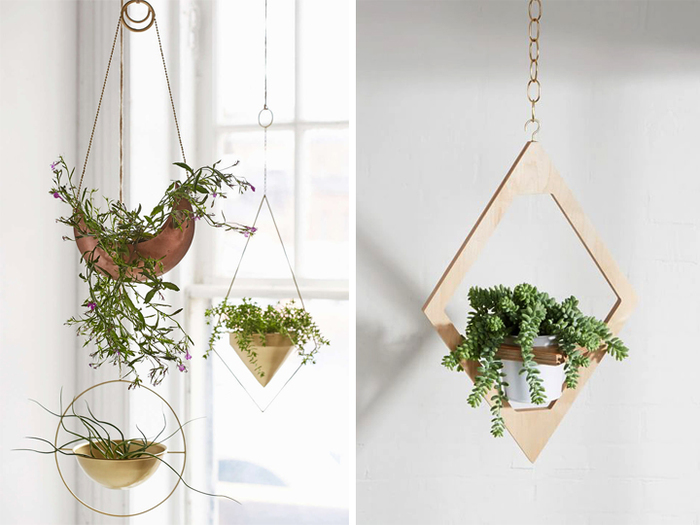 Hanging compositions
Hanging compositions
Wall compositions
Of course, we also need to pay attention to the shelves. Interesting compositions, exposed in proportion to the height in the same pots or at an equal distance from each other
The shelves can be anything - glass, wood, carved. At the discretion of the interior designer of the apartment.
 Compositions of flowers on the shelves
Compositions of flowers on the shelves
Floor compositions
In any apartment there are places that I would like to cover, for example, these are heating pipes along the entire wall. Then in the corner we put a tall plant in a pot - dracaena, ficus or palm tree.
These compositions are great for corridors and dark corners.
 Floor compositions
Floor compositions
Compositions on pedestals and stands
In large rooms, pedestals or decorative stands will become an original solution for the interior. They are forged, carved, of various styles and colors. The brighter the flower, the less complex the stand should be.
 Indoor plants on a stand
Indoor plants on a stand
Table compositions
Such compositions often decorate tables. So an orchid or a composition of succulents in special open vases will be a winning option. To decorate the table, it is advisable to use large glass vases, which are filled with multi-colored crystalline soil or colored sand, beautiful stones and other decor.
 Table compositions
Table compositions
Small plants with medium leaves are more suitable for kitchens and bedrooms so that they do not accumulate dust and dirt, and also save space.
Large and voluminous flowers fit perfectly in corridors and living rooms.
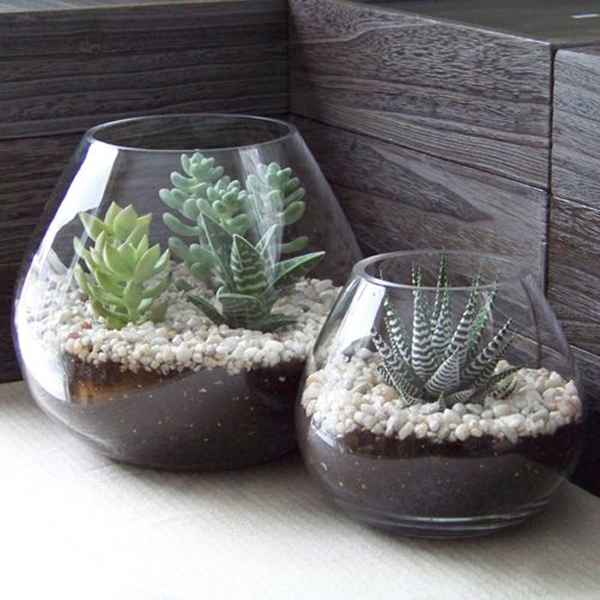 Succulents in vases
Succulents in vases
For inspiration, you can go to any flower shop, they often have new solutions.
Unpretentious indoor flowers: photos and names
The list of such plants is long. Below is a list of the most popular indoor flowers that do not require special conditions for their life.
Pelargonium. Attracts with an unusual shape of double flowers. Colors: white, red, pink, crimson. Pelargonium blooms almost all year round, delighting everyone with beautiful large inflorescences. It is also good in that it can be given any height - low, high. It is enough to move the flower to a darker place, as it will begin to stretch without losing its exquisite charm. It perfectly tolerates lack of watering and dry air.

Chinese rose. It does not require special care. A place well lit by the sun's rays is enough for her. It blooms all year round, spreading the subtle scent of its flowers throughout the room.

Fuchsia. Just like geranium, it has a wide range of colors. Cute "lanterns" can be white, purple, and red with different shades. Fuchsia begins to bloom from early spring to late autumn. On hot days, she loves spraying.
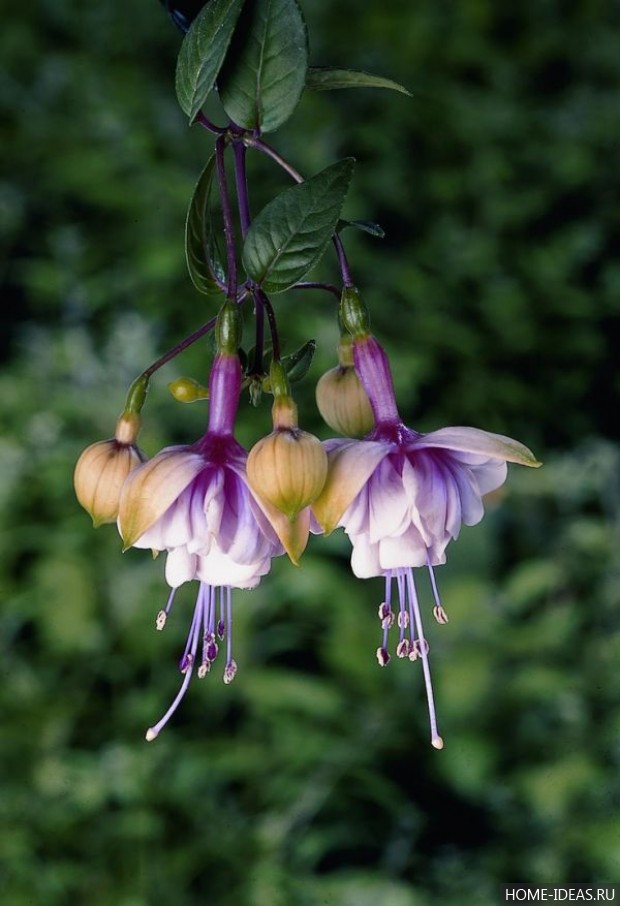
Anthurium ("male happiness"). The flowering period begins from the first days of spring and ends with the onset of the first frosts. Anthurium is a companionable flower, it is advisable to plant not one, but several such plants in one pot. A well lit and warm place is the best for anthurium. It does not tolerate drafts, but moist air is good for it. If you keep these flowers at home, we recommend purchasing a humidifier.


